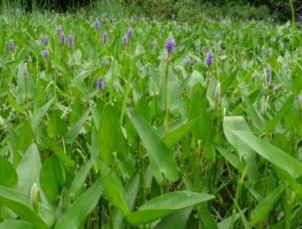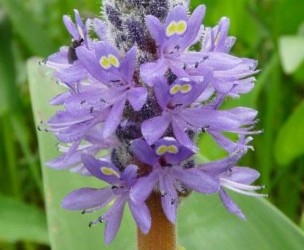Edible Aquatic Plants in Farm Ponds
ID
CNRE-127NP
Introduction
In Virginia, there are over 80,000 farm ponds. These ponds are used for various purposes but mainly for recreational use, such as fishing and boating. One of the primary complaints concerning farm ponds is having excessive aquatic weed problems. What many don’t know is that numerous aquatic weeds/plants can be eaten. Not all aquatic plants are edible, but many are. This short publication lists a few aquatic plants that are common to most farm ponds. There are many books on edible plants with sections on aquatic plants. Obtaining one of these books is the best approach for learning which ones you can eat. This is just a short guide to edible aquatic plants in your pond.
When it comes to edible plants, learn at least four to six that you can identify without any problems. Many parts of these plants are palatable. Spring and fall are the best times to look for these edible aquatic plants. The roots of the aquatic plants are reasonably tasty. The stems, flowers, leaves and pollen can be used in salads. Look for them and try them out.
You can find edible aquatic plants by walking along the bank or cruising the shoreline for them. Many of these plants located along the pond bank are known as emergent plants. Other plants are under the water and are known as submerged plants.
In this publication, you will find information on four aquatic plants found in Virginia that are edible. Most people can easily identify them. If you are not sure what you have, get an aquatic weed manual or edible wild plant guide to aid in identification.
Emersed Aquatic Plants
Cattails
Typha latifolia
The first edible aquatic plant to look for along the shore is cattails. These plants are easy to identify and found in most ponds and marshy areas. The best time to collect cattails is during the spring when roots and stems are at their best. Cattails belong to the genus Typha, and there are eleven species. Typha latifolia is the most common of the cattails found in the Northern Hemisphere.
Many parts of cattails are edible. For example, young stems can be eaten raw or boiled. The flower spikes are eaten during the early summer and can be roasted. Cattail pollen can be used as a flour or a thickener. The pollen can be used to make pancakes, homemade pasta and thicken stews and soups. Roots can be dried and pounded into flour. Cattails are known for having an edible root (rhizomes) like a potato. These are harvested from fall to spring. You may have to boil the root to make it tastier.
Edible Parts of a Cattail
Young stems: raw or boiled
Young flowers
Pollen as an additive
Young shoots
Root: cooked and eaten or made into flour


Water lily
Nymphaeaceae
Water lily belongs to the family of plants called Nymphaeaceae.
Water lilies are found floating in many ponds and are easily recognizable. The leaves of the water lily can get as large as a dinner plate. Many parts of the water lily are very edible. The flowers, seeds, roots (rhizomes) and young leaves can be consumed. The flowers, seeds and rhizomes are edible raw or cooked. To prepare rhizomes for eating, peel off the corky rind and eat raw or slice it thinly, allowing it to dry and then grind into flour. The young leaves and unopened flower buds can be boiled and served as a vegetable. Don’t forget the salad dressing. The seeds, high in starch, protein and oil, can be popped, parched or ground into flour.
These plants, the bulb and root are considered to have some medicinal properties for humans. Water lily has been used to settle intestinal imbalance.
Edible Parts of a Water Lily
Root is boiled or roasted
Young flowers and the leaves eaten raw or in soups and stews
Medicinal properties



Flower stem
Flower cross section
Anther
Filament
Stamen
Pistil
Seed pod
Seed
Pickerelweed
Pontederia cordata
Pickerelweed gets its name from Northern Pike, which is found in water where this plant grows.
Pickerelweed is an emergent plant with small violet- blue flowers forming a single spike that is 3-4 inches long.
The leaves are eaten as greens. The seeds are roasted and consumed as a nut, and can be cooked like rice or ground into a meal. Pickerelweed seeds are tasty when roasted, but they can be eaten raw or cooked. The seeds are best collected when they fall into your hand right off the plant. They can be ground and made into flour or toss some seeds into your bread recipe. The young leaves can be eaten as greens; boil older leaves before ingesting. Young stalks are also edible.


Edible Parts of a Pickerelweed
Young leaves eaten raw like greens
Older leaves can be eaten but boil first
Young stalks
- Seeds have many uses
Submersed Aquatic Plants
Coontail or Hornwort
Ceratophyllum demersum
Coontail is found completely underwater with a whorl having up to 12 leaves. Coontails are seen in large masses up to 11 feet or so in length. The leaves are considered edible and have medicinal properties, including treating dermatitis, fevers, sunburn and scorpion stings.
Edible Parts of a Coontail/Hornwort
Edible leaves
Has medicinal properties


- Stem
- Flower
- Young stamen
- Young pistil
- Adult pistil (Fruit)
Things to Remember About Aquatic Plants You Want to Consume
If you are looking for aquatic plants to consume, make sure you get them from a clean water source. Wash the plants thoroughly before cooking and especially if consuming raw.
Make certain you accurately identify the edible aquatic plants
Harvest only from a clean water source
Carefully and safely harvest the plants
- Clean and cook the plant properly before consuming it
Safety First
Never harvest aquatic plants alone. Make sure someone knows where you are in case something happens.
Wear proper clothing, such as boots and waders to stay dry. For safety, wear a properly fitting life vest.
Have clean tools and harvest equipment, such as knives, shovels, spades, etc.
Properly wash the plants before consuming them.
In Summary
The world is full of edible wild plants. Many can be found in your backyard, forest and fields. The aquatic environment has many plants that are easily identified and are edible. Learn these four aquatic plants and start your adventure to collect and eat the bounty of nature from your pond.
References
Thomas Elias and Peter Dykeman. 2009. Edible Wild Plants: A North American Field Guide to Over 200 Natural Foods.![]()
Samuel Thayer, 2006, The Forager's Harvest: A Guide to Identifying, Harvesting, and Preparing Edible Wild Plants.
Additional Resources
Indian Time: cattails, Mother Earth’s Grocery Store:
https://www.indiantime.net/story/2009/06/11/environment/cattails-mother-earths-grocery- store/2522.html
Edible Water Plants: Aquatic Vegetables:
http://natures-water.com/education_information/edible_plants/
Edible Wild Food: Edible Aquatic Plants:
https://www.ediblewildfood.com/edible-aquatic- plants.aspx
Virginia Cooperative Extension materials are available for public use, reprint, or citation without further permission, provided the use includes credit to the author and to Virginia Cooperative Extension, Virginia Tech, and Virginia State University.
Virginia Cooperative Extension is a partnership of Virginia Tech, Virginia State University, the U.S. Department of Agriculture (USDA), and local governments, and is an equal opportunity employer. For the full non-discrimination statement, please visit ext.vt.edu/accessibility.
Publication Date
January 7, 2021



